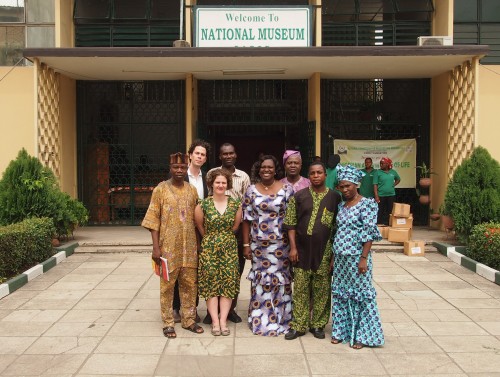
Richard McCoy with Amanda Thompson, MfAA registrar , and senior staff at the National Museum of Lagos.
*Ed. Note: This is the first post in a five-part series by Richard McCoy on the art and artists he encountered during a recent trip to Nigeria.
At the conclusion of the Indianapolis Museum of Art (IMA) exhibition, Dynasty and Divinity: Ife Art in Ancient Nigeria, I was invited by the U.S. organizer, the Museum for African Art (MfAA), to help their registrar, Amanda Thompson, with the return of more than 100 important artworks to their home country — the works had been out of Nigeria for three years, travelling to six venues in Europe and the USA.
It was truly a privilege to play even a small part in returning these artworks to Nigeria, and a mind-changing experience traveling to Africa for my first time.
While our work days were busy carefully examining each artwork to ensure that it was in the same condition as when it left, in the evenings and weekends I investigated a number of galleries, exhibitions, and studios of contemporary artists working in and around Lagos. What I saw were individuals looking at the rich history and traditions of Nigeria through the lens of the 21st century, in some cases preserving traditions and in others challenging the colonial past and current government, which is infamous for its corruption.
Staying at the hotel Bogobiri House, with its live music just about every night and walls and courtyard filled with contemporary art, it felt like I was at one of the centers of the Lagos art scene. Bogobiri, which is also home to the gallery, Nimbus, is owned by Chike Nwagbogu; he has received a lot of attention for his ideas of putting art at the center of the transformation of Nigeria.
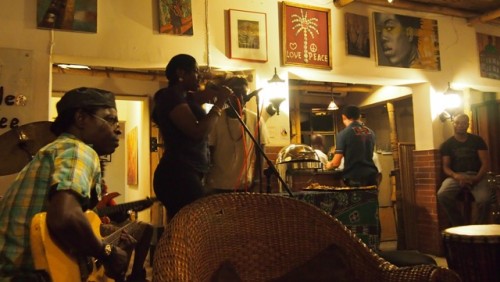
Musicians at the Bogobiri House. Photo by Richard McCoy.
You may be aware of a number of prominent artists who are from, working in, or otherwise connected to Nigeria, including the famous musician Fela Kuti, his son Femi Kuti, Art 21 artists Yinka Shonibare MBE (Season 5 episode, “Transformation“) and El Anatsui (Season 6 episode, “Change“) or others including Bruce Onobrakpya (and his “Harmattan Workshop“), Nenna Okore, and Chris Ofili. Perhaps you’ve heard of the Lagos-based auction house, Arthouse Contemporary, which recently held its seventh auction since 2007 with sales over ₦112 million (about $700,000), or saw the exhibition at the Tate Modern, Contested Terrains, which featured four artists working in Africa, including Lagos-based photographer Adolphus Opara. All of this is evidence to the rising importance and global interest in contemporary art from Nigeria.
In the sprawling and rapidly-growing city Lagos, with a population that is largely uncounted (estimates range between 8 and 12 million people) I only scratched the surface as to what can be seen. This post is not meant to be a definitive look at art and culture in Lagos and Nigeria, but more of a personal exploration. Following this post, I will be writing short profiles of few critically-engaging artists I met along the way, and a profile of the Center for Contemporary Art, Lagos. Please check back!
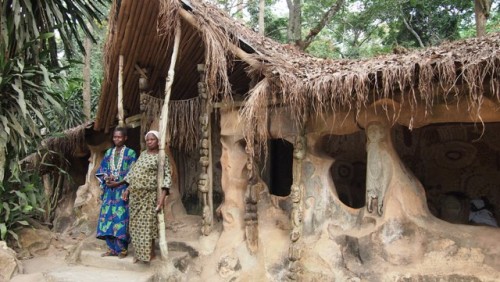
Priests standing in front of a temple at the Osun-Osogbo Sacred Grove. Photo by Richard McCoy.
The first weekend we were in Nigeria, we took the opportunity to drive out of Lagos to see the Ife Museum, the Oba’s Palace, the Pottery Museum, and the recently-active archaeological site, Yemoo Grove, all in the city of Ife. From there we continued on to the Osun-Osogbo Sacred Grove, a UNESCO World Heritage Site.
In a country with city and roads dense with activity and cars, it was refreshing to explore the peaceful sacred grove that leads down to the Osun river banks — tall trees, white-throated monkeys, lizards, and butterflies fill the grove. With massive concrete sculptures by Susanne Wenger, smaller stone sculptures of Yoruba deities by Buraimoh Gbadamosi, and others associated with the Osogbo-based New Sacred Art movement, this rare place is the site of the Osun-Osogbo festival, which is held every August (see the National Museum for African Art exhibition A Concrete Vision: Oshogbo Art from the 1960s, or the book Osogbo and Art of Heritage: Monuments, Deities, and Money for more info).
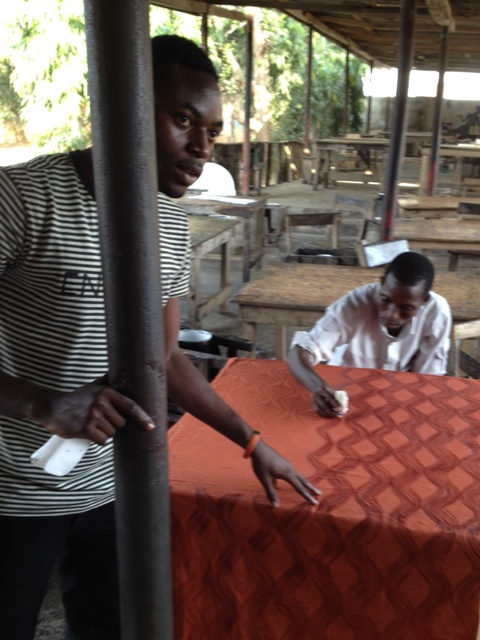
Man applying wax on a cloth in preparation for dyeing. Photo by Richard McCoy.
Before leaving Osgobo, we stopped in to visit one of the workshops owned by Oyenike Monica Okundaye, “Nike.” Nike is well-known artist, famous for her beautiful Adire cloths and paintings, especially those made in conjunction with the artist Tola Wewe. The Nike Art Workshop in Osogbo is a place where students learn the traditions of batik dying (a wax-resist technique). Since we were there on the weekend, the were only a few people at the workshop, but you can see that when it operates at capacity it is a bustling center of activity.
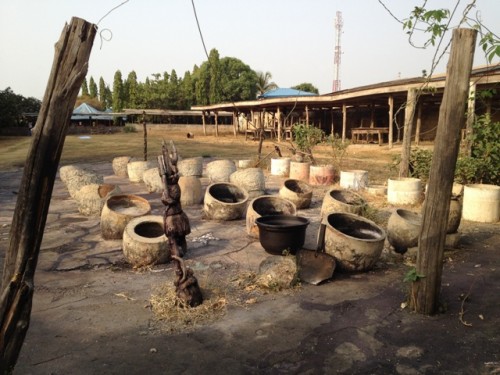
Dye vats at Nike Art Center in Osogbo. Photo by Richard McCoy.
Nike is a remarkable woman with a long history in Nigerian arts, and an enterprising business woman who operates a number of projects around traditional arts in Nigeria, including guided tours of the country based on cultural heritage. She also owns a four-story gallery back in Lagos, filled with over 9,000 artworks by many of the leading artists in the country (and a variety of more decorative works).
On Sunday we visited her gallery in Lagos where she very kindly made us lunch — on the menu, of course, was “pounded yam,” which is a traditional Nigerian way to serve yam. Always up for a challenge, I jumped in and tried my hand at the hard work of pounding yam.
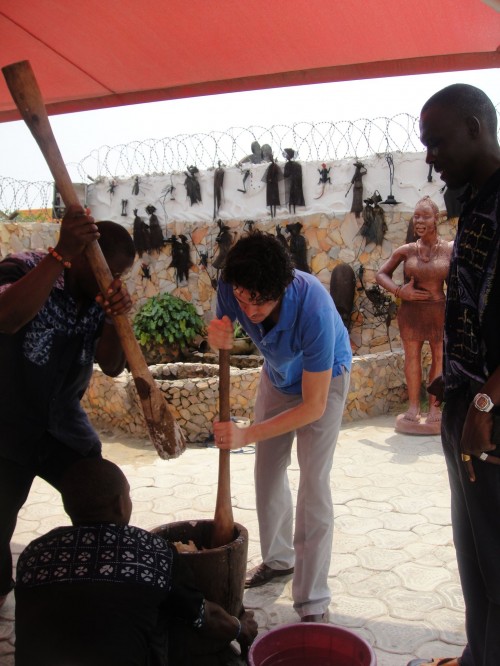
Pounding Yam at Nike Art Gallery in Lagos. Photo by Amanda Thompson.
After lunch we spent the afternoon looking around the gallery and meeting a few artists that came and went while we were there. She carries many of the better-known artists from Nigeria, including work by Twins Seven Seven, Rom Isichei, Bruce Onobrakpya, and Jimoh Buraimoh, among many others. I was fortunate to purchase some very small pieces by Lucky Isaiah, Godwin Ekaname, Buraimoh Gbadamosi, and some traditionally-dyed fabric from Nike’s workshops.
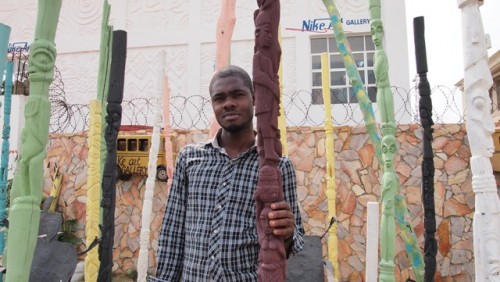
Moses Ogbeide, a fifth-generation wood carver from Benin City, Nigeria with his garden of traditional house posts painted bright colors in front of Nike Art Gallery, Lagos. Photo by Richard McCoy.
After work one day, I walked over to the Goethe Institute, Nigeria. Housed in the Lagos City Hall building, the Goethe Institute offers a small gallery space and a variety of projects; on view when we were there was a very engaging exhibition, Conrad’s Circus, For Crown and Country, by Mudi Yahaya. This challenging exhibition is worthy of an in-depth review that I’m planning for another publication.
Later in the week, once our work was finished, we drove up to the Center for Contemporary Art, Lagos (CCA), which was recently a locus for activities around the the Occupy Nigeria movement. (Next in this series, I’ll have a post dedicated to the CCA — check back!).
Finally, just a note to say that unlike the U.S., there are still a lot of print newspaper in Lagos, but only a few good blogs dedicated to the arts. Here’s a link to a list of art galleries in the city — if you know of others, please leave them in the comments — and below are a few art blogs I’ve found:
- a view from my corner (Jess Castellote’s personal blog on contemporary art in Nigeria)
- Arts with Tajudeen Sowole (Art news, previews/reviews and more … every week)
- WORDSBODY; Writings of the general word’s body (by Molara Wood)
I’ve been back in the US for about a week, but I’ve been thinking about my experiences and the people I met in Nigeria every day. With a steady stream of Fela and Femi Kuti now playing in the background, it’s hard not to think about Nigeria often — the beauty, personal struggles, trash littered streets, hazy skies, and kind people. (And, yes, we did make a late night run out to the New Afrika Shrine — an amazing environment with Femi and his band sounding great.)
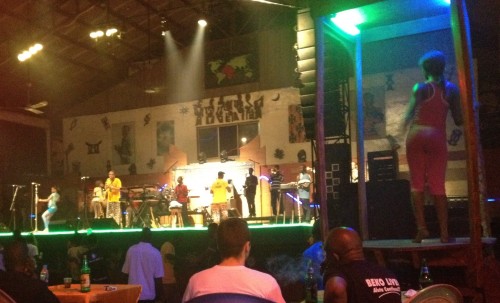
Femi Kuti and his band on stage at the New Afrika Shrine. Photo by Richard McCoy.




Pingback: No Preservatives | Looking Back to Nigeria [Part I] | Benjamin Phillips
Pingback: No Preservatives | Looking Back to Nigeria: The Center for Contemporary Art, Lagos [Part II] | Art21 Blog
Pingback: No Preservatives | Looking Back to Nigeria: Ben Osaghae’s Critical Observations [Part III] | Art21 Blog
Pingback: Mr McCoy I Presume « Dan Cull Weblog